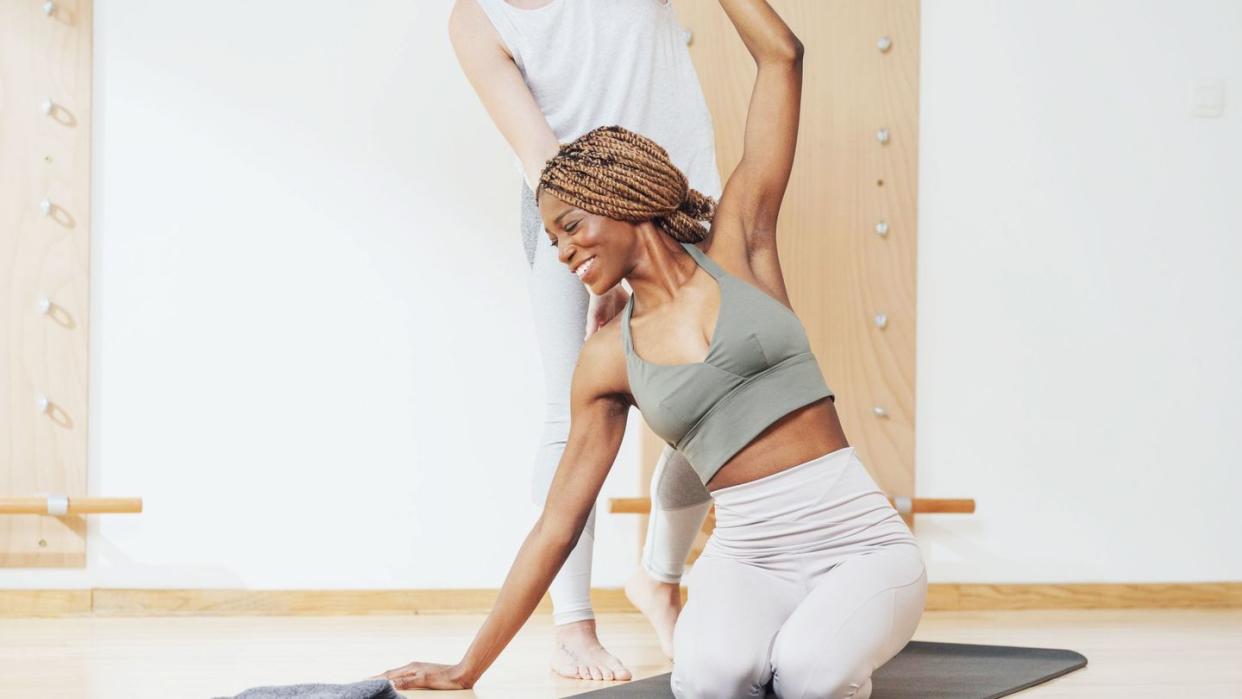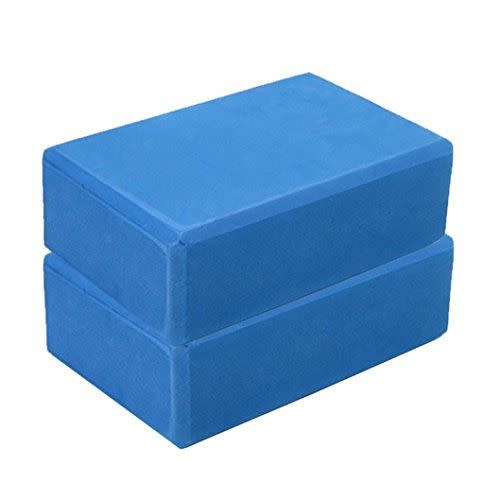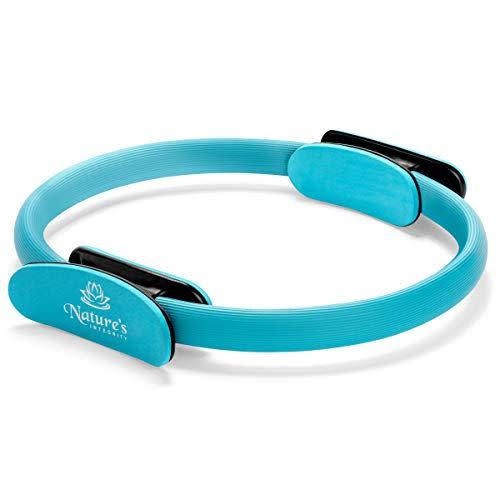Pilates Is Nearly 100 Years Old And Still One Of The Best Total-Body Workouts

"Hearst Magazines and Yahoo may earn commission or revenue on some items through these links."
Ever walk past a Pilates studio and wonder if the equipment inside is some kind of medieval torture device? You're not alone. Despite being nearly 100 years old, the workout method still remains a mystery to most people who don't already practice it.
If you’ve never tried Pilates, the appeal and experience of taking a class, either in-studio or online, or signing up for a private session might not be so obvious. But the first thing you should know is that “Pilates is more than a fitness routine,” says Marina Kaydanova, founder of BK Pilates in New York City.
“It’s meant to fix alignment and improve mobility," she explains. "In that way, it’s sort of a form of physical therapy.” Pilates workouts are all about slow, controlled movements that tone muscles, increase muscular endurance, and promote good posture and balance.
And in case you were wondering why it gets capitalized when yoga, for example, does not, it's because Pilates is named after its creator, Joseph Pilates, who developed the exercise style in the 1920s in Germany. Ever since, it's been popular with dancers, not to mention super-fit celebs (see: Kate Hudson), who swear by the fitness method because it's hardcore (read: lots of abs) but low impact.
Keep reading for everything you need to know before your first Pilates workout—plus, all the health benefits to expect after taking up the muscle-shaking sessions.
What happens in a Pilates class?
That depends a lot on what sort of session you sign up for. All classes fall under two main types: mat and reformer, though there are tons of variations—like those done on a bigger, supercharged Megaformer at studios like CHI50, the Studio MDR, and SLT.
The good news for newbies is that “you can achieve the same results with mat or reformer classes and can do either one if you’re just starting out,” says Kaydanova. The main difference is that using a machine gives you more options and can up the challenge, she notes. She also says to keep in mind that muscles are harder to target on the mat, which means "you just might need to add some props to a mat class for certain moves," she explains. "For instance, you can’t do inner thighs on a mat unless you have a magic circle.” WTH is a magic circle? More on that later....
Reformer classes add resistance with a spring-based machine. (Joseph Pilates created the first ones by rigging up springs on hospital beds.) “Moving on a reformer strengthens you as you move one way and stretches you the other way,” says Kaydanova. Using a machine makes it more interesting but also gives you more support than a mat class, she says, as you can play with resistance depending on your ability.
Mat classes don’t require a large machine, but you’ll likely reach for other pieces of gear—like a block, the aforementioned magic circle (also known as a Pilates ring), and mini exercise ball—to pump up certain moves, add stability to exercises, and help you connect with your deepest core muscles.
Exercise Blocks

Pilates Ring

Exercise Ball

Aside from there being two types of Pilates workouts (reformer and mat) there are also two styles of Pilates workouts—classical and contemporary—and the exercises you’ll perform has everything to do with which one you choose.
Classical style runs you through 34 of the same exact moves (with straightforward names like the roll up, spine twist, jack knife, and the all-time classic abs moves the Hundred) in the same exact order every session. (Moves can be altered slightly depending on your level.)
Watch this video to get familiar with a dozen common exercises you'll likely do in your first Pilates workout:
Contemporary style classes, on the other hand, mix in more creative choreography and exercises from other fitness modalities such as lunges, plank variations, and other popular bodyweight resistance moves. If you're not sure which style the studio or instructor you're taking lessons from teaches, just ask.
No matter which type and style of Pilates workout you choose, you’ll likely hear some new lingo during your first lesson. Common terms your instructor might use include: control, alignment, C-curve, roll up and roll down, and articulate (meaning to roll down one vertebra at a time). Don't worry, though, you're teacher will either demo or talk through what each of these terms means and offer adjustments and cues to help you execute them properly.
No matter what Pilates workout you choose, prepare to feel it: “People are surprised after the class, how sore they are and how much they hurt, even if the class is paced more slowly than they expected,” says Kaydanova. But you’ll also feel good. You’ll likely walk out of the studio a little lighter on your feet than when you came in—feeling more elongated and relaxed, since stretching is half the point of Pilates.
What should you wear to and expect from your first Pilates workout?
Think form-fitting. A pair of leggings or Spandex shorts and a sports bra or not-too-baggy tank are the way to go, and many studios require students to wear socks with grippy treads on the soles.
How often should you do Pilates?
For the best results, aim for a few weekly sessions. “Two to three times a week is ideal,” says Kaydanova. “But what I always say is: Everything you do is more than you didn’t do.”
Will Pilates help you lose weight?
It definitely could—but it might depend on how much you exercise to begin with. Women who did Pilates three times a week for eight weeks lost weight and inches in their waist and improved their BMI, in one small study from Pamukkale University in Turkey. However, the women in the research were overweight and inactive beforehand.
If you already get your sweat on often, adding Pilates to your routine might not end up tipping the scale down. But even if you don’t drop pounds, adding muscle and improving your posture make the workout a win-win.
What else is Pilates good for?
A lot. Research has shown that hitting the mat regularly improves muscular endurance and flexibility. After just eight weeks of a Pilates routine, people showed improved flexibility in a study published in the Journal of Sports Medicine and Physical Fitness. It’s also a killer core workout, which can not only give you envy-worthy abs, but can also help you stand up straighter and nix back pain.
Are there any risks to practicing Pilates?
All in all, it’s a pretty safe workout to pick up. “Pilates is very welcoming and safe for your body,” says Kaydanova. That being said, for the best experience, you should always let your instructor know about any injuries or conditions you’re experiencing. If you’re pregnant, for instance, you can totally keep up a Pilates routine—but your teacher will let you know all the tweaks you need to make to keep the session safe.
You Might Also Like